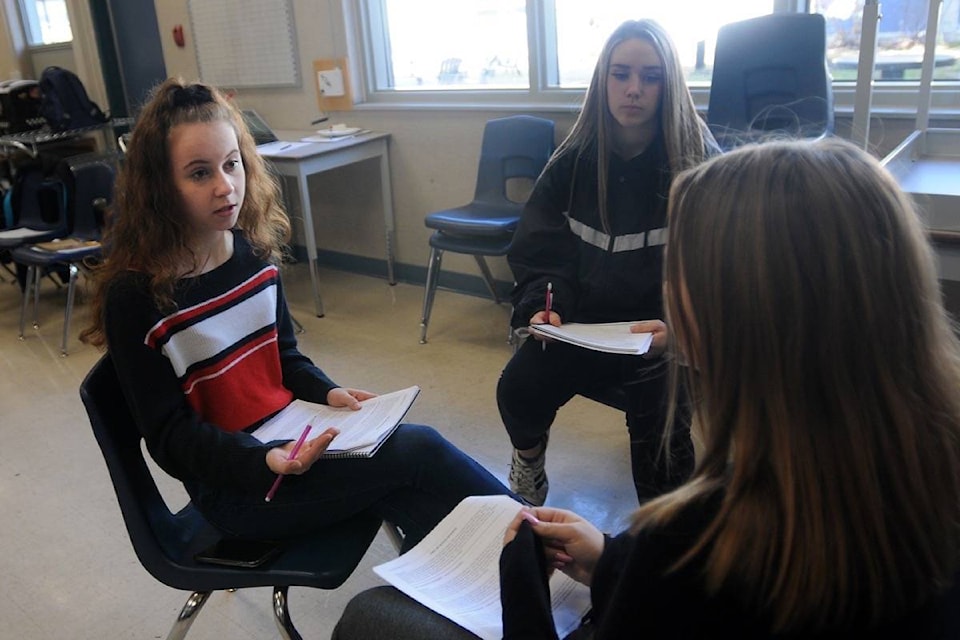A new conflict resolution program offering an alternative to suspension is being piloted at three SD42 schools.
Teachers at Highland Park and Harry Hooge elementary schools, as well as students and teachers at Westview secondary school, have been trained in the new Restorative Justice Program thanks to Maple Ridge Pitt Meadows Community Services that received a $9,000 Civil Forfeiture grant to put towards the initiative.
The program started on Oct. 25 with two sessions based on Community Justice Institute trainings called Talking Peace and Conversation Peace.
RELATED: New location for Maple Ridge’s Community Services
Around 20 students and 10 school district personnel at Westview received 28 hours of training where they learned to articulate and apply the principals of restorative justice, reflect on their use of a variety of conflict management styles, demonstrate key communication and listening skills, facilitate dialogue between students in conflict, discern when a case require a higher level of intervention and learn how to create an environment where there are open conversations where victims feel empowered.
At the elementary school level, 30 school district personnel received 14 hours of training where they learned how to deal with harm and conflict in ways that promote education, accountability, learning, fairness and a stronger school community, learned to work with bullying and exclusion and develop a foundation in mediation skills.
Christianne Paras, training and education coordinator with the Fraser Region Community Justice Initiative in Langley, whose role is to provide training in various communities, was leading the training session at Westview secondary.
Paras said the hope is to create safer and more respectful classroom and school communities.
If, for example, there was a physical altercation, said Paras, student facilitators would meet with each of the parties and have conversations about what happened, what were the impacts, how did they feel when it happened and how have things been going since. Then when both parties were ready, they would bring them together and have a conversation about the incident with the hopes of it leading to an agreement that would support both parties moving forward.
RELATED: Maple Ridge restorative justice program gets B.C. award
Grade 11 student Janay Stenmark said that she doesn’t see conflict on a day-to-day basis at Westview, but maybe on a weekly basis.
She has seen physical fights before, she said, that are not fun to watch. But, she said, that being able to deal with the aftermath of a physical fight in a restorative way instead of suspending a student is really important.
Jacob Moys, Gr. 11, joined the training session because he wanted to learn more conflict resolving skills to help his school out and the students at the school. He doesn’t see fights happen often, but when he does, he says, they are more verbal conflicts that have the potential of escalating to physical fights.
Moys says the Restorative Justice model is a better method of dealing with conflicts at the school because rather than dishing out a punishment where a student feels excluded, this model brings both sides together and offers a solution where both feel satisfied.
And, he said, some students may fear adults because they think they are going to get in trouble, but can relate better to a peer their own age.
Program coordinator Ranjit Kingra said that the great thing about restorative justice is that it is an alternative to suspension.
“Let’s have a look at what’s going on rather than suspend somebody,” said Kingra because staff don’t truly understand what happened and if there are any underlying issues going on with the student.
At the elementary school level, said Kingra, it’s about giving the teachers, education assistants, principals and councillors the tools need to hold a discussion in the classroom about respect, honesty and trust.
If a student complains that they were perhaps bullied on the playground, it gives a teacher the opportunity to discuss the harm that’s been done, what values have been broken and what the expectations are for the future.
Kingra says high school students are learning how they can be peer facilitators within their own school who will be able to bring together the conflicting parties and have conversations with them individually about who was harmed, how they have been harmed, can the relationship be repaired and what will that look like.
The Langley school district has the Restorative Justice model fully operational in all of their schools, said Kingra, adding that schools in the Tri-Cities are also following this model, along with schools in Chilliwack.
“It’s students offering a solution within their own school,” she said.
cflanagan@mapleridgenews.com
Like us on Facebook and follow us on Twitter
